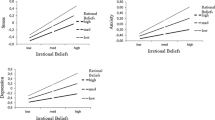Abstract
Despite the extensive use of the Velten Mood Induction Procedure (VMIP) for the analogue study of cognitive factors in emotional disorders, researchers have ignored individual-difference variables in the susceptibility to mood induction. In the present study, extreme groups were selected on the Irrational Beliefs Test (IBT), a measure of subjects' endorsement of Ellis' irrational beliefs. Twenty-seven rational and 27 irrational subjects were exposed to the VMIP positive, neutral, or negative self-statement conditions and were given a pre- and post-induction MAACL to assess dyphoric mood states. As predicted, the results were interactive, with irrationals showing affective susceptibility to negative VMIP but not to positive VMIP, and vice versa for rationals. Implications for theory, research, and practice are discussed.
Similar content being viewed by others
References
Abramson, L. Y., Seligman, M. E. P., & Teasdale, J. D. (1978). Learned helplessness in humans: Critique and reformulation.Journal of Abnormal Psychology, 87 49–74.
Beck, A. T. (1976).Cognitive therapy and the emotional disorders. New York: International Universities Press.
Buchwald, A. M., Strack, S., & Coyne, J. C. (1981). Demand characteristics and the Velten Mood Induction Procedure.Journal of Consulting and Clinical Psychology, 49 478–479.
Cash, T. F. (1984). The Irrational Beliefs Test: Its relationship with cognitive-behavioral traits and depression.Journal of Clinical Psychology, 40 1399–1405.
Craighead, L. W., & Craighead, W. E. (1980). Implications of persuasive communication research for the modification of self-statements.Cognitive Therapy and Research, 4 117–134.
Craighead, W. E., Kimball, W. H., & Rehak, P. J. (1979). Mood changes, physiological responses, and self-statements during social rejection imagery.Journal of Consulting and Clinical Psychology, 47 385–396.
Ellis, A. (1962).Reason and emotion in psychotherapy. New York: Lyle Stuart.
Ellis, A. (1977). Research data supporting the clinical and personality hypotheses of RET and other cognitive-behavior therapies. In A. Ellis & R. Greiger (Eds.),RET: Handbook of rational-emotive therapy (pp. 35–71). New York: Springer.
Frost, R. O., & Green, M. L. (1982). Velten Mood Induction Procedure effects: Duration and post-experimental removal.Personality and Social Psychology Bulletin, 8 341–347.
Goldfried, M. R., & Sobocinski, D. (1975). Effects of irrational beliefs on emotional arousal.Journal of Consulting and Clinical Psychology, 43 504–510.
Gouaux, C., & Gouaux, S. M. (1971). The influence of induced affective states on the effectiveness of social and nonsocial reinforcers in an instrumental learning task.Psychonomic Science, 22 341–343.
Guidano, V. F., & Liotti, G. (1983).Cognitive processes and emotional disorders: A structural approach to psychotherapy. New York: Guilford Press.
Hale, W. D., & Strickland, B. R. (1976). The induction of mood states and their effect on cognitive and social behavior.Journal of Consulting and Clinical Psychology, 44 155.
Jones, R. G. (1968).A factored measure of Ellis' irrational belief systems with personality and maladjustment correlated. Wichita, Kansas: Test Systems.
Mahoney, M. J. (1974).Cognition and behavior modification. Cambridge, Massachusetts: Ballinger.
Mitchell, J. E., & Madigan, R. J. (1984). The effects of induced elation and depression on interpersonal problem solving.Cognitive Therapy and Research, 8 277–285.
Mukherji, B. R., Abramson, L. Y., & Martin, D. J. (1982). Induced depressive mood and attributional patterns.Cognitive Therapy and Research, 6 15–21.
Natalie, M. (1977a). Effects of induced elation-depression on speech in the initial interview.Journal of Consulting and Clinical Psychology, 45 45–52.
Natalie, M. (1977b). Induction of mood states and their effect on gaze behaviors.Journal of Consulting and Clinical Psychology, 45 960.
Polivy, J. (1981). On the induction of emotion in the laboratory: Discrete moods or multiple affect states?Journal of Personality and Social Psychology, 41 803–817.
Rehm, L. P. (1977). A self-control model of depression.Behavior Therapy, 8 787–804.
Riskind, J. H., & Rholes, W. S. (1983). Somatic versus self-devaluative statements in the Velten Mood Induction Procedure: Effects on negativistic interpretations and on depressed mood.Journal of Social and Clinical Psychology, 1 300–311.
Riskind, J. H., Rholes, W. S., & Eggers, J. (1982). The Velten Mood Induction Procedure: Effects on mood and memory.Journal of Consulting and Clinical Psychology, 50 146–147.
Rogers, T., & Craighead, W. E. (1977). Physiological responses to self-statements: The effects of statement valence and discrepancy.Cognitive Therapy and Research, 1 99–119.
Strickland, B. R., Hale, W. D., & Anderson, L. K. (1975). Effect of induced mood states on activity and self-reported affect.Journal of Consulting and Clinical Psychology, 43 587.
Teasdale, J. D., & Fogarty, S. J. (1979). Differential effects of induced mood on retrieval of pleasant and unpleasant events from episodic memory.Journal of Abnormal Psychology, 88 248–257.
Velten, E. A. (1966). A laboratory task for induction of mood states.Behaviour Research and Therapy, 6 473–482.
Weinberger, H. L., & Cash, T. F. (1982). The relationship of attributional style to learned helplessness in an interpersonal context.Basic and Applied Social Psychology, 3 141–154.
Zuckerman, M., & Lubin, B. (1965).Manual for the Multiple Affect Adjective Check List. San Diego: Educational and Industrial Testing Service.
Author information
Authors and Affiliations
Rights and permissions
About this article
Cite this article
Cash, T.F., Rimm, D.C. & MacKinnon, R. Rational-irrational beliefs and the effects of the Velten Mood Induction Procedure. Cogn Ther Res 10, 461–467 (1986). https://doi.org/10.1007/BF01173297
Issue Date:
DOI: https://doi.org/10.1007/BF01173297



